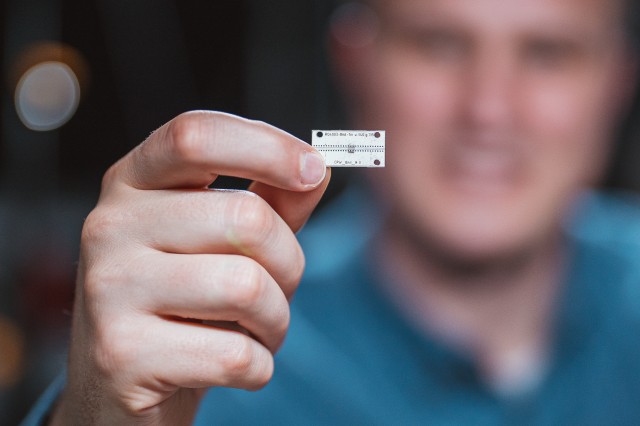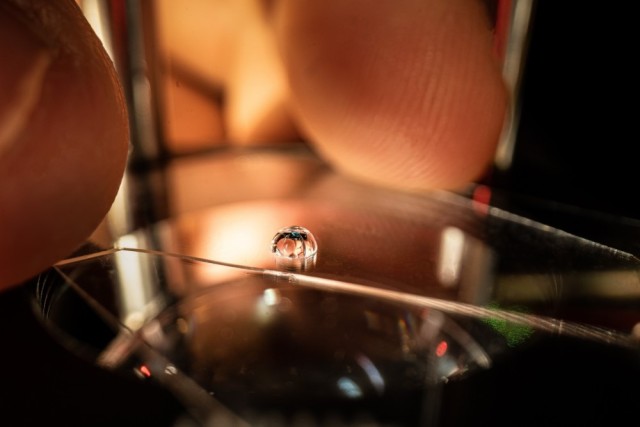MCQST's Seed Funding program helps launch a new project from Andreas Stier and Dominik Bucher
Seed Funding: A Match Made in Munich
If it were an online dating site, you’d certainly call it a match. A physicist and a chemist, who probably wouldn’t have met if it weren’t for the Munich Center for Quantum Science and Technology, are currently developing a new kind of quantum camera. Andreas Stier and Dominik Bucher intend to use it primarily to study ultra-thin 2D materials. “These materials are booming,” Stier says. The discovery of one of these materials, graphene, won the Nobel Prize in Physics in 2010. The idea for the collaboration was born during a meeting about quantum sensors, novel high-precision measuring instruments that utilize properties of quantum mechanics, such as spin, to accurately determine the physical properties of materials. At the meeting, the chemist Dominik Bucher from TU Munich presented his work on diamonds. And Andreas Stier, a physicist at the Chair of Semiconductor Nanostructures and Quantum Systems (SNQS, Prof. J.J. Finley) at the Walter Schottky Institute, thought to himself: “We’ve got lots of new magnetic 2D materials we’d like to study.” They talked and hit it off right away – on a personal level as well – and decided to take a chance on something together and to break new ground. “We immediately realized that we were a good match,” both scientists say.
 Assembly of a microwave antenna with epitaxially grown diamond. © Christoph Hohmann (MCQST)
Assembly of a microwave antenna with epitaxially grown diamond. © Christoph Hohmann (MCQST) When interviewed in their respective laboratories, both researchers are highly confident about the success of their projects. “It is a huge vote of confidence in us – that our idea could lead to something”, says Bucher. “It motivates us and is conducive to creativity.” He says there is great value in being able to try out ideas quickly. “We can work incredibly flexibly and dynamically.”
Andreas Stier nods and is already a step ahead, discussing the possible applications for the camera. Stier describes the incredible possibilities of atomically thin materials, which give rise to amazing properties. Increasing miniaturization makes it possible for materials to be made thinner and thinner. “Some of it is mind-boggling”, Stier says. “For example, no gas can penetrate single-layer carbon.” When the materials are that thin, some suddenly end up becoming superconductors, some magnets, some semiconductors, and others metals. The properties often have their origins in quantum mechanics, Stier says. “This field will offer many more surprises. It has incredible potential, and we might even discover a whole new type of physics here.”
And Dominik Bucher intends to help understand these wondrous effects. “We perform spectroscopic studies on the materials here at our facility”, Bucher says. To study atomically thin layers, researchers need atom-thin sensors. And Bucher is developing them in his lab. He uses diamonds for this purpose, specifically those that have small defects on their surface – imperfections in their lattice structure. The quantum sensors can measure with high precision and detect the smallest changes in temperature as well as in electric and magnetic fields. Specially prepared defects are, in fact, extremely sensitive to the magnetic properties of molecules located near their surface. “The diamond chips used in our project alone cost 10,000 euros”, says Bucher. “Therefore, we didn’t have to submit any complicated applications to buy them; it all happened incredibly quickly."
Bucher and Stier are now searching for what they call “exciting cases”: materials such as platinum diselenide, which, when made ultra-thin, suddenly becomes magnetic. Or various layers of graphene which, when slightly twisted, sometimes become magnetic, and sometimes superconducting, depending only on the angle of rotation. “It’s like Nano-Lego”, says Stier. “Sometimes I feel like I’m playing with these new materials.”
In Stier’s lab, the first magnetic field measurements are underway, albeit with a “boring” material for now. Stier laughs. “We’re examining rust”, he explains. “Applied extremely thinly”. The setups in his lab are complex despite the “mundane” material. Large magnetic field coils surround the samples, which can be used to control the external magnetic fields in a targeted fashion. A cryostat cools the sample down to temperatures close to absolute zero, a laser bombards the sample with light, and a CCD camera on the side is then used to image the magnetic field. Stier says that producing the ultra-thin sample – which is only three atomic layers thick – and then gluing it to a small plate is an art in itself. And it is precisely within this threshold range that each atomic layer also drastically changes the properties of a material.
 Quantum sensors such as nitrogen-vacancy centres enable a wide range of optical quantum applications. A solid-immersion lens with embedded quantum emitters produced from a single diamond allows for optimised light collection, thus reaching outstanding sensitivities. © Christoph Hohmann / MCQST
Quantum sensors such as nitrogen-vacancy centres enable a wide range of optical quantum applications. A solid-immersion lens with embedded quantum emitters produced from a single diamond allows for optimised light collection, thus reaching outstanding sensitivities. © Christoph Hohmann / MCQST Bucher and Stier are excited about the possibilities their novel quantum camera could offer in the future. “We started with one sheet of paper”, Bucher says. “Now we have up to ten people working on our collaborative project.” He notes that they’ve already been able to demonstrate that their quantum camera concept works. According to Bucher, they can now consider taking the next step and tackling larger projects, such as an ERC grant from the European Community, or a DFG project. They have already written applications for 2.5 million euros in funding. The DFG project is called “Imagine 2D” and describes the search for new material properties and for new physics. Recently, the DFG approved funding for a new type of device, which will surpass the capabilities of the quantum camera many times over. This will significantly expand the technical possibilities in the field of quantum sensing for the investigation of quantum materials, at MCQST and beyond. It seems the seed funding has already started to sprout.